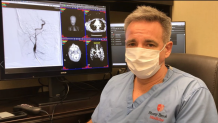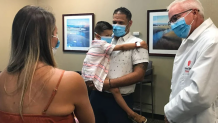
It took a split second for a metal straw to puncture the artery in a 4-year-old boy’s neck, cutting off blood supply to part of his brain and leaving blood to gush from his mouth with every heartbeat.
Just moments earlier, Charlie DeFraia had been sitting on the porch ledge of his family’s home, sipping a yogurt drink through the straw when he lost his balance and fell, setting up a chain of events that left him near death.
The force of the fall sent the metal straw in his mouth through his tongue and into his throat, piercing the right carotid artery — one of four major arteries that supply blood and oxygen to the brain.

Courtesy Stony Brook Medicine
The freak accident, which happened on June 20 in East Moriches, New York, highlights the danger of metal straws, especially for children, doctors said. A British woman died when she was impaled by the rigid straw after a fall in 2019. Three years earlier, Starbucks recalled millions of metal straws after reports of kids cutting their mouths on them.
Mystery wound
Get Tri-state area news delivered to your inbox. Sign up for NBC New York's News Headlines newsletter.
Charlie’s injury was catastrophic, but no one knew what was happening at first. The straw never broke the skin so there was no external wound on his throat. The straw remained in the yogurt drink, offering no clues about what had just happened.
U.S. & World
The boy’s mom, Crystal DeFraia, 38 — who had bought the metal straws after seeing what discarded plastic straws could do to sea turtles — heard the “bloodcurdling scream” of Charlie’s sister, 8-year old Madison, who was also on the porch, and ran to the site.
“I just saw blood on his face. I assumed he busted his nose or his lip, or bit his tongue. I never could have imagined that it was as serious as it was,” the high school teacher told TODAY.
Charlie’s dad, who is an internal medicine doctor, jumped into life-saving mode. He, too, initially thought Charlie had bitten his tongue, but saw the situation was much more dire.
“It was evident that he was really losing a serious amount of blood, and he actually stopped breathing on me a couple times,” Dr. Charles DeFraia, 38, recalled. “I had to protect his airway, and that’s really all I could do at that point.”
When the family called 911, an ambulance happened to be nearby and arrived quickly to rush Charlie to the hospital. The couple frantically followed in their car. “As a parent, you’re spiraling. You’re watching your son dying in front of your eyes,” Crystal DeFraia said.

Courtesy Kristy Leibowitz
"Blood everywhere"
On the way to Stony Brook University Hospital, the paramedics declared a pediatric code T — the highest level of trauma activation. Police shut down every road on the way there, allowing the ambulance to arrive at the hospital in 13 minutes, compared to 45 minutes in regular traffic.
“As soon as they wheeled him in, there was just blood everywhere. I’ve been a surgeon for over 30 years, and it was a lot of blood,” said Dr. Richard Scriven, chief of pediatric trauma at Stony Brook Trauma Center.
“He had really no measurable blood pressure. … He essentially had lost nearly all his blood.”
A simple tongue laceration couldn’t have caused such trauma, so Scriven suspected a carotid artery injury, but there was still no explanation how it could have happened. His chief resident asked the parents: Could there have been anything that punctured Charlie in his throat area? That’s when the DeFraias thought of the straw.
“I was like, now this unfortunately totally makes sense,” Scriven recalled.

Getty Images
Fears of brain damage
He and Dr. David Chesler, director of pediatric neurosurgery at the hospital, stopped the bleeding by packing the back of Charlie’s mouth with gauze. The boy was intubated and received transfused blood.
But scans showed a complete loss of blood flow in Charlie’s right carotid artery along with evidence that his brain wasn’t getting enough blood because of the injury, Chesler said.
“I wasn’t worried about him dying at that point. My unknown was what kind of neurological insult he was going to suffer from this,” he noted.
The torn artery had to be fixed, but Chesler realized neither he nor other surgeons could operate in the damaged area because it was too high up in the carotid, tucked in behind the boy’s jaw.
That’s when he called in Dr. David Fiorella, director of the Stony Brook Cerebrovascular Center, “because he’s a wizard with catheters,” Chesler said.
How the hole was sealed
Fiorella faced a huge challenge: He needed to save that vital blood vessel to the brain somehow, but also shut off the massive bleeding. Just clamping it off wasn’t an option.
So Fiorella made a small puncture in Charlie’s right femoral artery in the thigh and inserted a thin flexible tube, also known as a catheter, through it. He manipulated the catheter so it traveled inside Charlie’s body from the thigh to the site of the injury in the neck, and rebuilt a new artery using standard metal stents, “so there was a scaffolding there,” Fiorella said.

Courtesy Stony Brook Medicine
He then deployed a stent with a covering on the outside, which sealed the hole.
“It’s a stent graft, so what it did is recreated a brand new carotid artery inside Charlie’s old carotid artery,” Fiorella said.
“In doing that, it not only stopped the bleeding and sealed off the bleeding, but also restored normal blood flow to the right side of Charlie’s brain.”
The procedure took about 45 minutes from start to finish.

Courtesy Stony Brook Medicine
Kids have an 'unbelievable ability' to recover
Charlie spent a week in a medically-induced coma on a ventilator in the pediatric intensive care unit.
When he woke up, he couldn't move the left side of his body, but improved day by day. The boy is now moving normally, except for a couple of fingers on his left hand that have some lingering weakness.
“Kids his age just have the most unbelievable ability to recover from this damage that (adults) just can’t. It’s unreal what they can sustain and recover from,” Chesler said.
Charlie was discharged from Stony Brook Children’s Hospital on July 7. He’ll enter kindergarten on Sept. 7 and celebrate his 5th birthday a week later. He takes aspirin and Plavix, a type of blood thinner, but otherwise leads a typical child’s life, his mom said.

Courtesy Stony Brook Medicine
“We’re so thankful,” she noted, expressing her gratitude to the medical team.
“Everything fell into place for Charlie that day,” Scriven said. “I truly believe another five minutes and I don’t think we’d be looking at this beautiful boy here.”
As for metal straws, throw them in the garbage, he advised, “or at least don’t let children use it."
“They’ve been in the garbage since the day after the accident,” Crystal DeFraia said.
This story first appeared on TODAY.com. More from TODAY:



